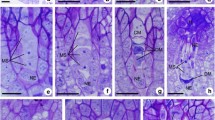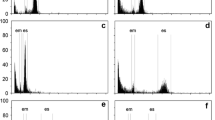Abstract
Polyploidy is a key process in plant evolution, with the asexual formation of embryos representing a way through which polyploids can escape sterility. The association between polyploidy and polyembryony is known to occur in Bignoniaceae. In this study, we investigate polyembryony in four polyploid species of Anemopaegma: A. acutifolium, A. arvense, A. glaucum and A. scabriusculum as well as in one diploid species, A. album. Polyembryony was observed only in polyploid species. We used seed dissection and germination tests to compare the number of polyembryonic seeds. We tested how the pollen source influences the number of polyembryonic seeds and the number of embryos per seed and tested the correlation between the number of viable seeds per fruit and mean number of embryos per seed. The number of polyembryonic seeds observed by seed dissection was higher than the number of polyembryonic seeds determined by the germination test, with the number of embryos produced per seed being higher than the number of seedlings. The dissection of seeds of A. glaucum indicated that a higher number of polyembryonic seeds and a higher number of embryos were present in seeds from cross-pollination than in seeds from self-pollination. On the other hand, germination tests indicated that a higher number of polyembryonic seeds were present in fruits from self-pollination than from cross-pollination. The mean number of embryos per seed was not influenced by the number of viable seeds per fruit in fruits from open pollination. These results indicate a positive relationship between polyembryony and polyploidy in Anemopaegma.



Similar content being viewed by others
References
Adams KL, Wendel JF (2005) Polyploidy and genome evolution in plants. Curr Opin Plant Biol 8:135–141
Asker SE, Jerling L (1992) Apomixis in plants. CRC Press, Boca Raton
Baker HG (1960) Apomixis and polyembryony in Paquira oleaginea (Bombacaceae). Am J Bot 47:296–302
Barringer BC (2007) Polyploidy and self-fertilization in flowering plants. Am J Bot 94:1527–1533
Bianchi MB, Harris SA, Gibbs PE, Prado DE (2005) A study of the mating system in Dolichandra cynanchoides (Bignoniaceae): an Argentinian Chaco woodlands liane with a late-acting self-incompatibility. Plant Syst Evol 251:173–181. doi:10.1007/s00606-004-0227-y
Bicknell RA, Koltunow AM (2004) Understanding apomixis: recent advances and remaining conundrums. Plant Cell 16:S228–S245. doi:10.1105/tpc.017921
Bittencourt Jr NS (2003) Auto-incompatibilidade de ação tardia e outros sistemas reprodutivos em Bignoniaceae. PhD Thesis, Universidade Estadual de Campinas
Bittencourt NS Jr, Moraes CIG (2010) Self-fertility and polyembryony in South American yellow trumpet trees (Handroanthus chrysotrichus and H. ochraceus, Bignoniaceae): a histological study of postpollination events. Plant Syst Evol 288:59–76. doi:10.1007/s00606-010-0313-2
Bittencourt NS Jr, Semir J (2004) Pollination biology and breeding system of Zeyheria montana (Bignoniaceae). Plant Syst Evol 247:241–254. doi:10.1007/s00606-004-0142-2
Bittencourt NS Jr, Semir J (2005) Late-acting self-incompatibility and other breeding systems in Tabebuia (Bignoniaceae). Int J Plant Sci 166:493–506. doi:1058-5893/2005/16603-0011
Bittencourt NS Jr, Semir J (2006) Floral biology and late-acting self-incompatibility in Jacaranda racemosa (Bignoniaceae). Aust J Bot 54:315–324. doi:10.1071/BT042210067-1924/06/030315
Bittencourt NS Jr, Gibbs PE, Semir J (2003) Histological study of post-pollination events in Spathodea campanulata Beauv. (Bignoniaceae), a species with late-acting self-incompatibility. Ann Bot 91:827–834. doi:10.1093/aob/mcg088
Bowden WM (1945) A list of chromosome numbers in higher plants. I. Acanthaceae to Myrtaceae. Am J Bot 32:81–92
Bowers JE, Chapman BA, Rong J, Paterson AH (2003) Unravelling angiosperm genome evolution by phylogenetic analysis of chromosomal duplication events. Nature 422:433–438
Calzada JPV, Crane CF, Stelly DM (1996) Apomixis—the asexual revolution. Science 274:1322–1323
Carman JG (1997) Asynchronous expression of duplicate genes in angiosperms may cause apomixis, bispory, tetraspory and polyembryony. Biol J Linn Soc 61:51–94
Correia MCR, Pinheiro MCB, Lima HA (2005) Produção de frutos e germinação de sementes de Anemopaegma chamberlaynii Bur. & K. Schum. (Bignoniaceae)—Um registro de poliembrionia. Sitientibus Ser Ci Bio 5:68–71
Costa ME, Sampaio DS, Paoli AAS, Leite SCAL (2004) Poliembrionia e aspectos da embriogênese em Tabebuia ochracea (Chamisso) Standley (Bignoniaceae). Rev Bras Bot 27:395–406
Darlington CD, Wylie AP (1961) Chromosome atlas of flowering plants, 2nd edition, 2nd impression. George Allen & Unwin LTD. London
de Wet JMJ (1971) Polyploidy and evolution in plants. Taxon 20:29–35
Firetti-Leggieri F (2009) Biossistemática das espécies do complexo Anemopaegma arvense (Vell.) Stellf. ex de Souza (Bignoniaceae, Bignonieae): aspectos anatômicos, citológicos, moleculares, morfológicos e reprodutivos. PhD Thesis, Universidade Estadual de Campinas
Firetti-Leggieri F, Costa IR, Forni-Martins ER, Lohmann LG, Semir J (2011) Chromosome studies in Bignonieae (Bignoniaceae): the first records of polyploidy in Anemopaegma Mart. ex Meisn. Cytologia 76:185–191
Gandolphi G, Bittencourt NS Jr (2010) Sistema reprodutivo do ipê-branco—Tabebuia roseo-alba (Ridley) Sandwith (Bignoniaceae). Acta Bot Bras 24:840–851
Ganeshaiah KN, Shaanker RU, Joshi NV (1991) Evolution of polyembryony: consequences to the fitness of mother and offspring. J Gen 70:103–127
Gibbs PE, Bianchi M (1993) Postpollination events in species of Chorisia (Bombacaceae) and Tabebuia (Bignoniaceae) with late-acting self-incompatibility. Bot Acta 106:64–71
Gibbs PE, Bianchi M (1999) Does late-acting self-incompatibility (LSI) show family clustering? Two more species of Bignoniaceae with LSI: Dolichandra cynanchoides and Tabebuia nodosa. Ann Bot 84:449–457
Grant V (1981) Plant speciation, 2nd edn. Columbia University Press, New York
Hörandl E (2010) The evolution of self-fertility in apomictic plants. Sex Plant Reprod 23:73–86. doi:10.1007/s00497-009-0122-3
Jullier S (1989) Cromosomas mitóticos de Doychandra cynanchoides y Macfadyena unguis-cati (Bignoniaceae). Kurtziana 20:215–217
Kokou Y, Akyo M, Shoji N, Koho KT (2000) Skin external use agent. JP-Patent Number 2000143482. May 23
Koltunow AM (1993) Apomixis: embryo sacs and embryos formed without meiosis or fertilization in ovules. Plant Cell 5:1425–1437
Koltunow AM, Grossniklaus U (2003) Apomixis: a developmental perspective. Ann Rev Plant Biol 54:547–574. doi:10.1146/annurev.arplant.54.110901.160842
Lakshmanan KK, Ambegaokar KK (1984) Polyembryony. In: Johri BM (ed) Embryology in angiosperms. Spring, Berlin, pp 445–474
Levin DA (2002) Polyploidy: incidence, types and modes of establishment. In: Levin DA (ed) The role of chromosomal change in plant evolution. Oxford University Press, Inc., Oxford, pp 98–133
Lee I, Lee YH, Leonard J (2002) Ursolic acid induced changes in tumor growth O2 consumption and tumor interstitial fluid pressure. Anticancer Res 21:2827–2834
Lohmann LG, Taylor CM (2013) A new generic classification of Bignonieae (Bignoniaceae) based on molecular phylogenetic data and morphological synapomorphies. Ann Mo Bot Gard
Masterson J (1994) Stomatal size in fossil plants: evidence for polyploidy in majority of angiosperms. Science 264:421–423
Mendes-Rodrigues C, Carmo-Oliveira R, Talavera S, Arista M, Ortiz PL, Oliveira PE (2005) Polyembryony and Apomixis in Eriotheca pubescens (Malvaceae-Bombacoideae). Plant Biol 7:533–540
Mendes-Rodrigues C, Ranal MA, Oliveira PE (2011) Does polyembryony reduce seed germination and seedling development in Eriotheca pubescens (Malvaceae-Bombacoideae)? Am J Bot 98:1613–1622. doi:10.3732/ajb.1100022
Mondragon JC (2001) Verification of the apomictic origin of cactus pear (Opuntia spp. Cactaceae) seedling of open pollinated and crosses from Central Mexico. J Prof Assoc Cactus 4:49–56
Naumova TN (1993) Apomixis in angiosperms: nucellar and integumentary embryony. CRC Press, Boca Raton
Naumova TN (1997) Apomixis in tropical fodder crops: cytological and functional aspects. Euphytica 96:93–99
Nogler GA (1984) Gametophytic apomixis. In: Johri BM (ed) Embryology in angiosperms. Springer, Berlin, pp 475–518
Oliveira PE, Gibbs PE, Barbosa AA, Talavera S (1992) Contrasting breeding systems in two Eriotheca (Bombacaceae) species of Brazilian cerrados. Plant Syst Evol 179:207–219
Ortolani FA (2007) Morfo-anatomia, citogenética e palinologia em espécies de ipê (Bignoniaceae). PhD Thesis, Faculdade de Ciências Agrárias e Veterinárias, UNESP, Jaboticabal, SP
Otto SP (2007) The evolutionary consequences of polyploidy. Cell 131:452–462. doi:10.1016/j.cell.2007.10.022
Otto SP, Whitton J (2000) Polyploid incidence and evolution. Ann Rev Gen 34:401–437
Pannell JR, Obbard DJ, Buggs RJA (2004) Polyploidy and sexual system: what can we learn from Mercurialis annua? Biol J Linn Soc 82:547–560
Pereira AMS, Salomão AN, Januário AH, Bertoni BW, Amui SF, França SC, Cerdeira AL, Moraes RM (2007) Seed germination and triterpenoid content of Anemopaegma arvense (Vell.) Stellfeld varieties. Genet Resour Crop Evol 54:849–854
Piazzano M (1998) Números cromossômicos em Bignoniaceae de Argentina. Kurtziana 26:179–189
Rieseberg LH (1997) Hybrid origins of plant species. Ann Rev Ecol Syst 28:359–389
Salomão AN, Allen AC (2001) Polyembriony em Angiospermous trees of the Brazilian cerrado and caatinga vegetation. Acta Bot Bras 15:369–378
Sampaio DS (2010) Biologia reprodutiva de espécies de Bignoniaceae ocorrentes no cerrado e variações no sistema de autoincompatibilidade. PhD Thesis, Universidade Federal de Uberlândia, MG
Schifino-Wittmann MT (2004) Poliploidia e seu impacto na origem e evolução das plantas silvestres e cultivadas. Rev Bras Agroc 10:151–157
Shimizu H (2001) Antioxidant containing plant extracts for cosmetics and pharmaceuticals. JP-Patent 20011139417. May 22
Silva MM, Queiroz LP (2003) A família Bignoniaceae na região de Catolés, Chapada Diamantina, Bahia, Brasil. Sitientibus Ser Ci Biol 3:3–21
Soltis PS (2005) Ancient and recent polyploidy in angiosperms. New Phytol 166:5–8
Soltis DE, Soltis PS (1999) Polyploidy: recurrent formation and genome evolution. TREE 14:348–352
Soltis PS, Soltis DE (2000) The role of genetic and genomic attributes in the success of polyploids. PNAS USA 97:7051–7057
Soltis DE, Albert VA, Leebens-Mack J, Bell CD, Paterson AH, Zheng C, Sankoff D, dePamphilis CW, Wall PK, Soltis PS (2009) Polyploidy and angiosperm diversification. Am J Bot 96:336–348. doi:10.3732/ajb.0800079
Souza LA, Iwazaki MC, Moscheta IS (2005) Morphology of the pericarp and seed of Tabebuia chrysotricha (Mart. ex DC.) Standl. (Bignoniaceae). Braz Arch Biol Technol 48:407–418
Spillane C, Calzada JPV, Grossniklaus U (2001) A sexy apomixer in Como. Plant Cell 13:1480–1491
Stebbins GL (1971) Chromosomal evolution in higher plants. Addison-Wesley, London
Teppner H (1996) Adventitious embryony in Nigritella (Orchidaceae). Folia Geobot Phytotax 31:323–331
Tucker MR, Koltunow AMG (2009) Sexual and asexual (apomictic) seed development in flowering plants: molecular, morphological and evolutionary relationships. Funct Plant Biol 36:490–504
Uchino T, Kawahara N, Sekita S, Satake M, Saito Y, Tokunaga H, Ando M (2004) Potent protecting effects of catuaba (Anemopaegma mirandum) extracts against hydroperoxide-induced cytotoxicity. Toxicol In Vitro 18:255–263
Uma Shaanker R, Ganeshaiah KN (1996) Polyembryony in plants: a weapon in the war over offspring numbers? Trends Ecol Evol 11:26–27
Uma Shaanker R, Ganeshaiah KN (1997) Conflict between parent and offspring in plants: predictions processes and evolutionary consequences. Curr Sci 72:932–939
Wakana A, Uemoto S (1987) Adventive embryogenesis in Citrus. I. The occurrence of adventive embryos without pollination or fertilization. Am J Bot 74:517–530
Acknowledgments
This research project was initiated as part of the doctoral thesis of the first author at Universidade Estadual de Campinas (UNICAMP), São Paulo, Brazil, and continued at the Universidade de São Paulo, São Paulo, Brazil. We thank the Reserva Ecológica do IBGE (Brasília-DF), the Universidade de Campinas (Campinas, SP) and Universidade de São Paulo for logistical support, as well as the Conselho Nacional de Desenvolvimento Científico e Tecnológico (CNPq-142233/2004-8 grant to FFL and a Pq-2 grant to LGL) for funding. The authors also thank Cintia Luíza da Silva Luz and Isabel Gomide Martinelli for assistance with the preparation of Figures and anonymous reviewer for comments and suggestions.
Author information
Authors and Affiliations
Corresponding authors
Additional information
Communicated by Scott Russell.
Rights and permissions
About this article
Cite this article
Firetti-Leggieri, F., Lohmann, L.G., Alcantara, S. et al. Polyploidy and polyembryony in Anemopaegma (Bignonieae, Bignoniaceae). Plant Reprod 26, 43–53 (2013). https://doi.org/10.1007/s00497-012-0206-3
Received:
Accepted:
Published:
Issue Date:
DOI: https://doi.org/10.1007/s00497-012-0206-3




